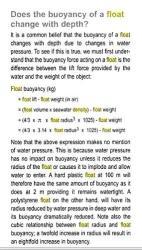I was trying to imagine how a float could "select" a certain depth and pull part of a net down or up to that depth.
Since water is almost completely incompressible (*), I couldn't think of ways an object could have different buoyancy at different depths, other than these two, so I thought "trawler floats can't be depth-specific!"
1. the float compresses under pressure (same mass, smaller displacement volume). That would cause it to have
less buoyant force at greater depths.
However, if a net dragged such a float down a little, the buoyant force would become less and the net would tend even more strongly to fall.
To be depth-specific, a float would have to become MORE buoyant as it went deeper, so that the weight pulling it down would eventually reach an equilibrium.
2. the float's density is
exactly equal to seawater, so there is a TINY lifting or sinking force moving it to find the precise salinity and temperature to match the density of the float.
But the force is tiny: only the float's volume times the
difference in density between seawater at different depths, and water is almost totally incompressible, so the density change is TINY.
Then I found a book that seemed to agree with me.
https://books.google.com/books...
It said in part:

I was content with that answer until I started to think about it.
But I came back to thinking the same thing, so you can skip this following digression with no loss!
Maybe the "hollow" would make the floats select a certain depth and float or sink with significant force to reach that depth, if the air can't escape from the hollow.
Hmmm.
Imagine a bucket held carefully upside-down so air can't escape. It floats at the surface since a lot of air and a little sheet metal are much lighter than an equal volume of water.
Now add bricks until the bucket just starts to sink.
It will sink until water pressure compresses the air and lets some water into the hollow space. You can say this either way:
1. the mass of the bucket-shaped-
volume increased a lot, by the mass of the water entering it. The volume "stayed the same" because we are counting the entire volume of the bucket-shaped cubic, whether it is filled with water or air.
2. the volume of the AIR-FILLED part of the bucket just dropped greatly while the mass stayed the same. (In #2, we no longer count the volume filled with water as p[art of the "bucket").
The volume is less, so the bucket
displaces less water, so the buoyant force is less.
However, this case (no matter which way you look at it) is just like the case where "the float compresses under pressure". As soon as you give it enough weight that it
starts to sink,
its buoyancy decreases with depth and it sinks faster and deeper.
If I'm right, you could add bricks and pebbles until the bucket JUST had neutral buoyancy as it floated JUST below the surface of the water. Now add one small grain of sand. Now it's heavier and sinks an inch. That compresses the air a little, buoyancy decreases a little, and the bucket is heavier and sinks faster. More compression, less buoyancy, faster sinking.
Promptly the bucket falls to the bottom of the pool and hits with a CLUNK.
That would not have held any part of a net at any specific depth.
As a check, imagine a very strong plastic bag, sealed tight and unburstable, floating at the surface. Add bricks until it just starts to sink. It will sink faster and faster as it compresses.
Now I'm back to thinking that
I don't understand any way a float could be depth-specific.
Increased pressure compressing air "goes the wrong way": it creates positive feedback which makes a bucket go "clunk" to the bottom or float stubbornly on the surface.
If water were highly compressible (like gasses are), any rigid object would float to the depth where pressure compressed the fluid to the exact density of the rigid object. But, the force the object could exert on the net (sinking or buoyant force) is only the object's volume times the difference in density between the object and whatever level the net dragged it to (away from its neutral-buoyancy-depth)
Anyway, that's the way it looks to me right now. I could be wrong: I changed my mind twice while trying to figure this out.
(*)
Allegedly, at one mile of depth in seawater, the pressure is around 150 times atmospheric, but water only compresses 1%!
If that's linear, at 530 feet water only compresses 0.1%.
At 53 feet, 0.01%. (0.01% is like a factor of 0.0001)
A gallon of water weighs 8.34 pounds ("a pint's a pound the world 'round").
So the density difference from the surface to 53 feet of depth would make one gallon weigh 0.00834 pounds = 0.13 ounces = 4 grams more.
I don't think 4 grams per gallon of float volume (translated into force) would drag a very big net up or down very far.
